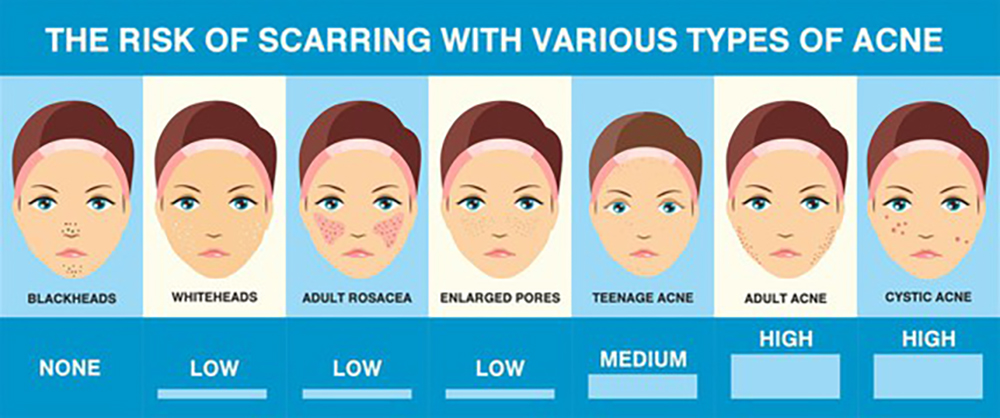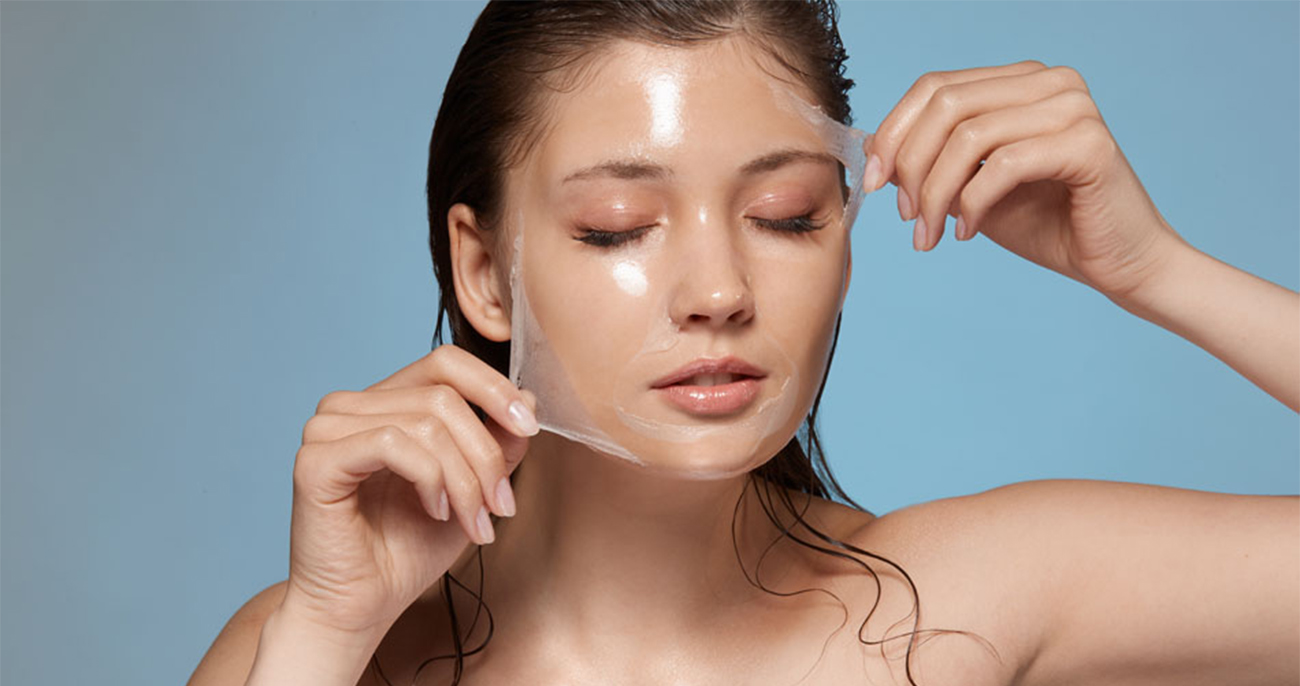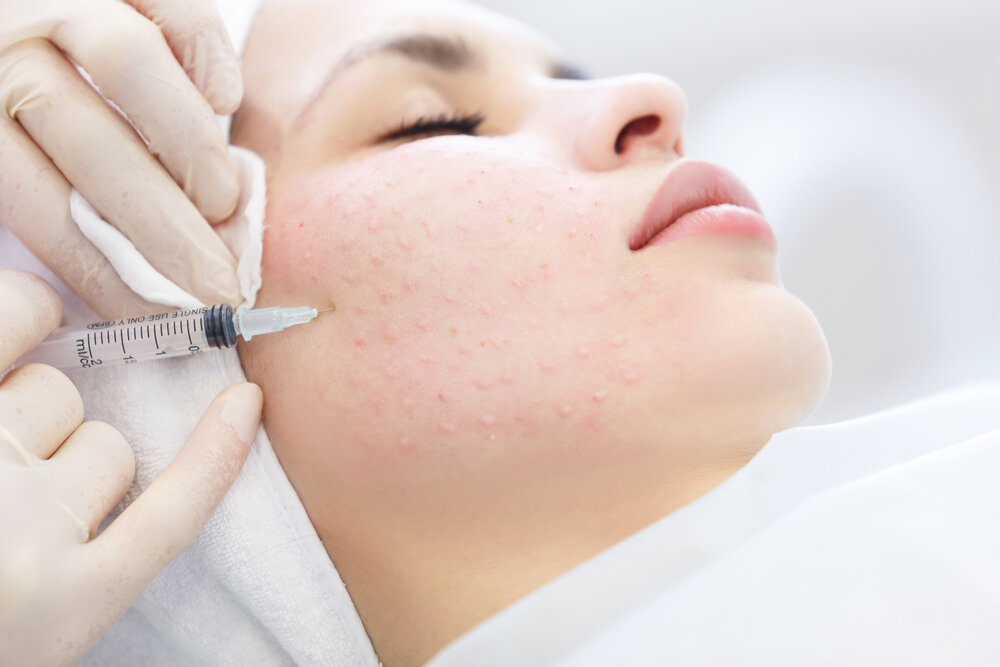Acne is usually a temporary problem, but acne scars usually become permanent. Acne scars cause significant psychological stress and affects one’s self esteem.
Scars occur as a result of the skin’s normal healing process after it has been damaged by infection or injury. Most superficial wounds heal without scarring. It’s when the deeper layer of skin is damaged that scars form on the skin.
Causes Of Acne Scars
Acne lesions occur when follicle or pore becomes blocked by excess oil and dead cells followed by inflammation and subsequently bacterial infection. The swelling of the blocked pores causes a break in the follicle wall. If the rupture occurs close to skin surface, the lesion is minor and heals quickly. When the inflammation and break of follicle wall occurs deep in the skin, the infected material spills out into the dermis and causes damage to surrounding.tissue as seen in nodular cystic acne.
The skin naturally will repair the damage done. During the repair, the skin forms new collagen fibres. Collagen is a fibrous protein that results in the overlying skin being pulled down resulting in a scar.

The greater the inflammation and longer the healing process, the higher the chance of scarring.
Types of Scars
- Ice-pick scars : Deep scars that look like pits on the surface of skin.
- Boxcar scars: Broad depressions with obvious, defined edges.
- Rolling scars : Like boxcar scars but with sloping edges
- Hypertrophic/ Keloid scars: The scars protrude from the skin. Although both look similar, they are not the same. Keloids tend to be larger scars that extend beyond the wound edges and often described as having edges that spill over. On the other hand, hypertrophic scars stay within the boundaries of the wound. In hypertrophic scar there is more collagen formed than broken down during the healing. Keloid scars are caused by uncontrolled production of collagen. These individuals form keloids even from minor injuries to the skin.
Scars are either atrophic or hypertrophic. Most commonly seen scars are atrophic or depressed scars. Ice pick scars and boxcar are atrophic scars. Keloid and hypertrophic scars are hypertrophic scars
Brown or black spots on the skin are often mistaken for as acne scars. These are not true scars, but rather post-inflammatory hyperpigmentation. Read more on post inflammatory hyperpigmentation
Treatments of Acne Scars
There isn’t a one-size-fits-all solution for each type of acne scar. That is why there is a variety of acne scar removal treatments which are tailored to the scar type and severity of scars. Scar removal is a difficult process and usually will require several types of treatments together to obtain optimal results. Most treatments work by stimulating collagen production within the skin to restore to its original or smoother state.
Chemical Peels 
Chemical peels work by removing damaged top layer of skin, increase collagen production, leaving skin smoother. Since acne scars affect deeper layers of skin.The most effective chemical peel has to be a deep peel, such as the Obagi Blue Peel. Read more on Obagi Blue Peel
Dermal Fillers
Dermal fillers made from hyaluronic acids work by filling up depressed atrophic scars as well as stimulating collagen production that further smoothens the scar. Fillers are injected under the scar and immediate improvement is seen and scar continues to improve. Read more
TCA CROSS
TCA is an abbreviation for trichloroacetic acid which is used for a chemical peel and it improves scars through exfoliation and stimulation of collagen.
TCA CROSS is useful for atrophic scars such as boxcar, rolling and ice-pick scars.
TCA CROSS procedure involves placing small amounts of high concentration onto the surface of atrophic scars. This causes local inflammatory reaction leading to formation of new collagen fibres.5 sessions recommended with 4-6 weeks interval, for optimum improvement.
Subcision
Subcision is a micro-surgical procedure that is extremely effective in removing deep scars. It breaks down fibrotic tissue that is main cause of depressed scars in the skin. It is usually combined with fillers for better result.
The Subcision Procedure
The areas to be treated are injected with local anaesthesia.
An 18 or 23 Gauge needle is introduced under the scar, in the deeper layers of skin and scar tissue is broken down. The healing phase following subcision stimulates collagen production and improvement of scar. There may be swelling and bruising after the procedure which goes away after a few days.
Punch Excisions
This is an ideal one-off procedure that gets rid completely of boxcar and ice pick scars.The scar tissue is excised using a punch which is a sharp instrument that is of same size as scar to precisely excise just the scar. A suture is used to pull the edges of scar together, closing the gap. This leaves a thin scar in place of broader boxcar or deep ice-pick scar. Laser treatment or chemical peels will further improve scar appearance.
How Many Sessions Do I Need?
This depend on type of scar and individual’s healing potential. Usually 2-4 sessions 4 weeks apart give optimal
results.
Who Is Not Suitable For Subcision?
Subcision cannot be performed on those with history of abnormal skin scarring such as hypertrophic and keloid scars and those on blood thinners.
Stop all supplements such as garlic. Vitamin E, fish oils, and medication such as aspirin and NSAIDs as they may increase bleeding or bruising.
Intralesional Triamcinolone Injections
This is the most effective treatment for both hypertrophic and keloid scars, ability to flatten 50-100% keloids with minimal recurrence.Triamcinolone acetonide (Kenacort) is a form of corticosteroid. Steroids break the bonds between collagen fibres, which gradually reduces the amount of scar tissue.
In the clinic we combine triamcinolone with botulinum toxin as studies have shown faster and better results. Anaesthetic cream is applied for 20 minutes before the injection is done. There will be some pain and swelling post procedure which resolves the next day. Improvement of scar is seen after 3-4 weeks.
An injection into scar is done every 3-4 weeks continuously till optimal flattening of the scar occurs.
Potential side effects of steroid injections into the skin are depression or hypopigmentaion of skin at site of injection, These side effects are rare and occurrence are minimised by controlling amount of steroids and frequency of injections.
Polynucleotide S (Scar)
Polynucleotide is a treatment that originated from Korea. It uses Polynucleotide (PN) which is an upgraded form of Polydeoxyribonucleotide (PDRN) to boost collagen production.PN is extracted from salmon DNA as salmon DNA is most compatible with the human.
PN S is a more concentrated version of PN Healer. Healing effect plus density of product makes it ideal for treating acne scars
The Polynucleotide S Procedure
Anaesthetic cream is applied to skin for 20 minutes. PN is then injected just under the skin using very fine needle. Only areas with scars are treated. The procedure takes 15-30 minutes. After the injections, there may be some swelling that usually last 1-2 days. Occasionally bruising can occur and that last about 5 days.
How Soon Can I See Results and How Many Sessions Required?
It takes about 4-6 weeks before visible improvements seen. 5 sessions 3-4 weeks apart is recommended to achieve optimal results.
What Not To Do Before The Procedure?
Stop all supplements such as garlic. Vitamin E, fish oils, and medication such as aspirin and NSAIDs as they may increase bleeding or bruising. At the clinic we give patients an oral Arnica supplement to minimise swelling and bruising
Intense Pulse Light (IPL)
In some individuals patches of persistent redness on the face after acne has healed can be troublesome. It is due to excess proliferation of small blood vessels in area of injury. IPL is able to destroy the excess blood vessels thereby reducing the redness.
Several sessions weekly are required till redness subsides. Scar gel is recommended daily to assist with eradication of the redness.
Hollywood Facial
Hollywood Facial is a medi-facial ideal for those who wish to have a facial that treats the acne scar as well as makes the face look radiance and dewy. Recommended to be done every 3-4 weekly to get optimal results. Hollywood Facial can also be done post procedures to optimise the results plus aid in recovery from the procedures. Read more Medical Facials
Acne Scar Products
Tretinoin
Tretinoin also known as retinoic acid is a synthetic vitamin A product. The common brands of tretinoin are Retin A or Rectacnyl. Tretinoin improves acne scars through process of exfoliation as well as stimulation of collagen production. Tretinoin is not the same as Retinol which is found in OTC products. Tretinoin is a prescription drug and is more effective than Retinols. Retinols need to be converted into active retinoic acid by enzymes before it can work. Tretinoin does not require conversion and works directly on the skin. Tretinoin creams to be used only at night as it makes the skin sun sensitive. Tretinoin is known to cause skin irritation and dryness. It should be used once every few days with a moisturiser and gradually to increase to daily use depending on skin tolerance.
Retinoids accentuate effect of removal of scars when combined with treatments. Take note that retinoid should be stopped 3 days before procedures as it makes the skin more susceptible to complications from procedures.
Scar Gel
Indicated during early acne healing, where redness is the main feature. The scar gel also reduces the possibility of bad scarring
Sun Protection Cream
Sun protection with SPF of at least 30 with especially physical block is important during treatments as most treatments make the skin sensitive to the sun. The sun protection prevents further inflammation due to sun exposure. Minimizes incidence of post inflammatory hyperpigmentation.
How You Can Prevent Acne Scars
Treat acne as early as possible to reduce likelihood of scars. If you are prone to nodular cystic acne and keloid , best solution is to be treated with Isotretinoin to stop more pimples and stop more scars.
Don’t squeeze, pop or pick on pimples. In doing so infection is spread to surrounding tissue and worsening of inflammation.
If you get a large, deep, very inflamed painful breakout get an appointment for immediate treatment, as such lesions are highly likely yo leave a bad scar.
Don’t pick at scabs. A scab protects the wound as it heals. Picking the scab before it heals completely prolonged the healing process and increases the chance of scarring.




